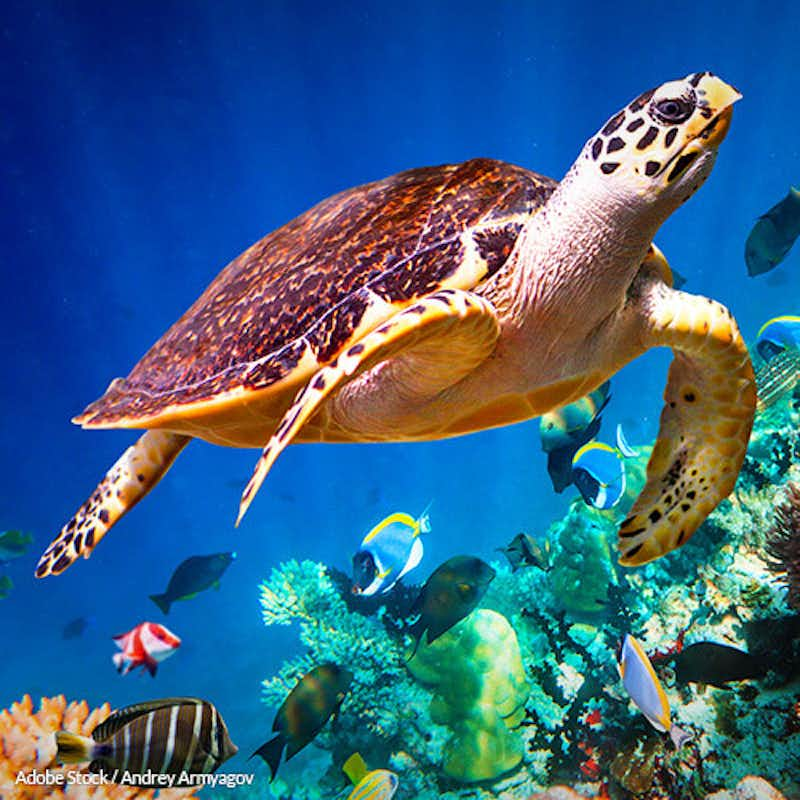Hawksbill Sea Turtles Don't Have to Be Bycatch!
28,459 signatures toward our 50,000 Goal
Sponsor: The Rainforest Site
Help mandate that fishermen use safer practices near Hawksbill sea turtle ecosystems!

Sign to add your voice in support for an international mandate that requires the use of TEDs and/or LED lights when fishing in and around hawksbill sea turtle ecosystems.
Hawksbill sea turtles are a species vital to both marine and beach ecosystems. Unfortunately, they are also critically endangered.
Hawksbill turtles are mainly found in the tropical waters of the Atlantic, Pacific and Indian oceans. [1] They spend the majority of their time in coastal waters, near coral reefs where they have access to the sponges and jellyfish that make up a significant portion of their diets.
Their presence in these areas is crucial to maintaining a healthy ecosystem. By consuming sponges, they facilitate the growth of coral reefs, and when they graze on sea grass, they stimulate the production and improve the nutrient quality of the plants. Research suggests that these activities qualify them as a keystone species, meaning their loss would be catastrophic to these diverse ecosystems. [2]
There are a variety of threats to this invaluable species, including pollution, habitat loss due to coastal development, excessive egg collection, and wildlife trade. Sadly, beyond that, hundreds of thousands of hawksbill sea turtles are killed annually, purely by accident. Because they reside in areas where communities are dependent upon fishing to support themselves, the turtles frequently become what is known as "bycatch" [3] when they are unintentionally captured in fishermen's drop nets and hooks. Once caught in nets, the turtles often drown, as they're unable to swim to the surface for air.
If we want to protect this keystone species, as well as the ecosystem they call home, this has to stop.
In the U.S., Turtle Excluder Devices (TEDs) are required by fishermen. These nets allow larger animals to escape through an opening near the back without losing their catch. Another solution has come about in the form of nets bearing LED lights [4], which divert sea turtles away from the nets before they're captured without affecting the number of fish caught. These lights are inexpensive, particularly when you compare the cost to that of killing a critically endangered species.
Unfortunately, many fishermen use neither TEDs nor LED lights to help combat the issue of hawksbill bycatch.
It's time for the National Oceanic and Atmospheric Administration's International Fisheries Division (IFD) to take a more proactive approach to hawksbill conservation! Sign to show your support for safer methods of fishing in all hawksbill sea turtle ecosystems by requiring the utilization of TEDs or LED lights to reduce hawksbill bycatch and working with local fishermen to develop an understanding of the importance of this keystone species!
Bibliography
[1] Hawksbill Turtle. (n.d.). Retrieved January 11, 2018, from https://www.worldwildlife.org/species/hawksbill-turtle
[2] E. Wilson, K. Miller, D. Allison, & Magliocca D. (n.d.). Why Healthy Oceans Need Sea Turtles: The Importance of Sea Turtles to Marine Ecosystems. Retrieved January 11, 2018, from http://oceana.org/sites/default/files/reports/Why\_Healthy\_Oceans\_Need\_Sea\_Turtles\_0.pdf
[3] Threats to Sea Turtles. (n.d.). Retrieved January 11, 2018, from http://www.seaturtleinc.org/rehabilitation/threats-to-sea-turtles/
[4] Fisheries, N. (n.d.). Lights, Camera, Bycatch; LEDs Light the Way for Chinook Salmon. Retrieved January 11, 2018, from https://www.fisheries.noaa.gov/west-coast/bycatch/lights-camera-bycatch-leds-light-way-chinook-salmon
The Petition:
To the National Oceanic and Atmospheric Administration's International Fisheries Division (IFD),
Hawksbill sea turtles have been established as a keystone species. However, they're also critically endangered due to outdated fishing practices.
These sea turtles are mainly found in tropical waters, in the Atlantic, Pacific and Indian oceans in coastal waters, near coral reefs. Their presence in these areas is crucial to maintaining a healthy ecosystem. The hawksbill's consumption of sea sponges facilitates the growth of coral reefs, and when they grace on sea grass, they stimulate the production and improve the nutrient quality of the plants.
The hawksbill is also a natural predator of the jellyfish, helping control the population of this species. Jellyfish blooms, when they occur, can devastate fisheries, halt aquatic recreation, and cause serious damage to power stations.
The loss of this species could be catastrophic and far-reaching. We have to protect the hawksbill sea turtle.
Deputy, there are options. It is up to you to mandate that fisherman be educated on the importance of this keystone species. Further, it is crucial that you mandate safer methods of fishing near hawksbill sea turtle ecosystems.